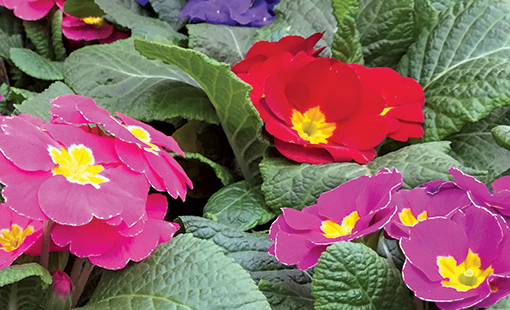
Growing Primrose Indoors
Garden primroses comprise several species in the Primula genus, a group of spring-blooming perennials that bloom in various shades of purple, red, yellow, pink, depending on the variety. They have deep green crinkled leaves that form a low clump, with bright dish-shaped flowers.
For indoor use, primroses are often sold with the expectation of growing them for a short time then discarding them after they are finished flowering. It is possible to nurture them into repeated blooming, but this is difficult. For the most part, you should not expect a long-lived houseplant. Rather, think of your pot of primrose like a blooming fall phalaenopsis orchid—it’s a beautiful visitor, but will not survive over the long term inside.
This is a somewhat finicky, slow-growing plant that is usually purchased as a mature nursery plant for short-term indoor display. Spring is usually when garden centers potted specimens, either already flowering or about to bloom. If planting from seeds or from divisions, you may wait a full year, or as much as three years, for the plants to reach flowering maturity.
Care
When grown indoors, primrose requires just the right combination of sunlight, water and food in order to survive. Extend the flowering season by pinching off the dying flowers. After the plant is done blooming, consider moving it outside; you may get additional blooms late in the season.
Keep these plants at a good balance of conditions; successfully growing primrose plants is largely a matter of temperance and moderation.
Light
When grown indoors, primrose prefers brightly lit windowsills but should not be exposed to direct sunlight. When planting them outside, put in a shady or dappled corner.
Soil
These plants need a loose, well-drained, very rich potting mix with a high level of humus. Most general-purpose potting soils based on peat moss provide this. You can make your own potting mix with even proportions of peat moss, vermiculite and perlite. This mixture not only holds moisture well but also offers very good drainage. Outdoors, primroses prefer a rich, well-draining soil that is slightly acidic.
Water
Primrose needs adequate, even and regular moisture to thrive. They shouldn’t be soggy, but don’t let the soil dry out, either. Look for signs of wilting and adjust watering accordingly.
When growing primroses inside, do not overwater. Too much water is an invitation to root rot or lethal fungal infections. Wilting, even though the plant is getting water, is a sign of root rot.
Temperature & Humidity
Primroses do best in moderate to cool temperatures—intense heat can cause wilting and plant failure. They grow best at temperatures between 50 to 65 degrees Fahrenheit and don’t much care for temperatures above 80 degrees. Primroses like high humidity, which can be provided through the use of a humidifier or by setting the pot in a saucer filled with pebbles and water.
Fertilizer
Feed with a weak liquid fertilizer at the start of the flowering period. Because these are not meant to be long-lived indoor plants, a single application of controlled-release fertilizer may be adequate to get them through the flowering season.
Propagating Primrose
Although the technique is more often used for primroses planted in the garden, division of the root clumps can also be used to propagate more plants from an indoor specimen. This is best done after the plant is finished blooming, when they are often discarded anyway.
Remove the entire plant from the pot, then carefully divided it into quarters, making sure each division has both leaves and a good body of roots. Immediately replant the divisions into their own pots filled with fresh potting soil or a mixture of peat moss, perlite, and vermiculite.
You can expect the new divisions to take a full year before they flower. Their slow-growing, finicky nature is why primroses are usually purchased as near-mature nursery plants.
Potting & Repotting
It’s unlikely you’ll be repotting your potted primrose since these are generally grown for a fairly short time before being discarded. If you do, make sure not to bury them too deep as it’s is a prime reason that primroses die. Pot the plants so the top of the root ball is slightly elevated above the level of the surrounding soil. Never pile soil up around the stem of a flowering plant.
Common Pests & Diseases
Primrose is fairly trouble-free when planted outdoors in conditions that are exactly to their liking. As potted indoor plants, however, they can subject to botrytis gray mold, which often occurs in winter months then the plants are over-watered. Make sure to remove dead or diseased leaves to remove fungal spores. A fungicide powder may prevent the disease.
Information courtesy of TheSpruce.com

 Adams Fairacre Farms
Adams Fairacre Farms